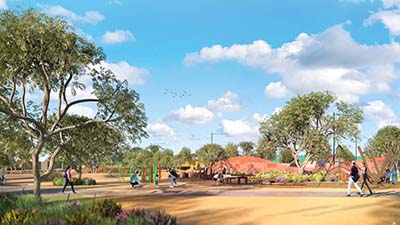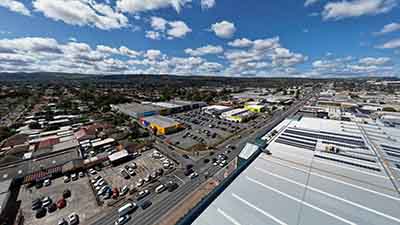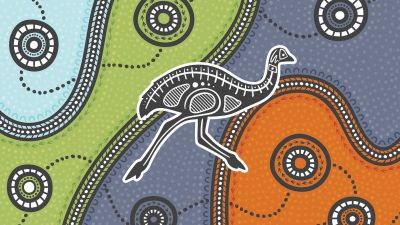Community and stakeholder engagement
The Department for Infrastructure and Transport (the Department) has undertaken extensive community and stakeholder engagement. This feedback has already helped shaped the T2D Project.
Engagement on the T2D Project began in November 2020 and has included several opportunities to seek feedback through many touch points with the community and interested stakeholders.
This engagement has focused on increasing people’s awareness of the project and creating meaningful opportunities for community and stakeholder input to help minimise potential impacts and maximise positive outcomes for the community.
Input has been sought on a range of project elements including the motorway design, local access and urban design. The engagement approach, methodology and supporting collateral for each phase of engagement has been bespoke and planned to suit the specific engagement purpose.
A range of tools have been used to engage with the community and stakeholders including meetings, workshops, letterbox drops, emails, a local face-to-face presence (at shopping centres, community hubs, information sessions) and digitally (via website, social media and online surveys).
Since December 2022 when the updated project design was released following a review of the project, we have had over 6,200 face-to-face interactions, issued five project updates to over 25,000 people, received over 1,700 online survey responses, responded to over 850 enquiries received via phone or email and issued over 100 notifications about early works.
Insights gathered through these engagement activities have helped shape project planning and design. It has also helped to inform and develop this Project Assessment Report (PAR). The feedback received has also been provided to the two shortlisted potential head contractors who are currently going through the tender process to ensure community insights are also incorporated into their proposals.
- Summary
Download a summary of the PAR in PDF format
Engagement approach
Community and stakeholder engagement has played a key role in the planning and design of the T2D Project. Throughout the life of the project, community and stakeholder input has been sought on a range of project elements including the motorway design, local access and urban design elements.
The feedback received so far has been used to shape project decision-making. It has also been provided to the two shortlisted potential head contractors, who are currently going through the tender process, and will be incorporated into their proposals.
The engagement approach has focused on:
- making useful and accurate information about the project easily available
- creating meaningful opportunities for community and stakeholder involvement
- being clear on the purpose of the engagement and explaining how feedback will be used
- actively listening to concerns and local insights to inform project decision-making
- proactively working to minimise potential local impacts and maximise local benefits
- doing what we say we will do.
Engagement on the T2D Project has been consistent with Better Together the overarching community engagement framework for how South Australian Government agencies are to conduct engagement. This framework is also aligned with the International Association of Public Participation's (IAP2) Quality Assurance Standard.
Most engagement for the T2D Project has and will continue to occur at the ‘Inform’ and ‘Consult’ levels of the IAP2 Spectrum. Opportunities to involve the community further in project planning will be proactively identified. This is likely to include placemaking and public space elements.
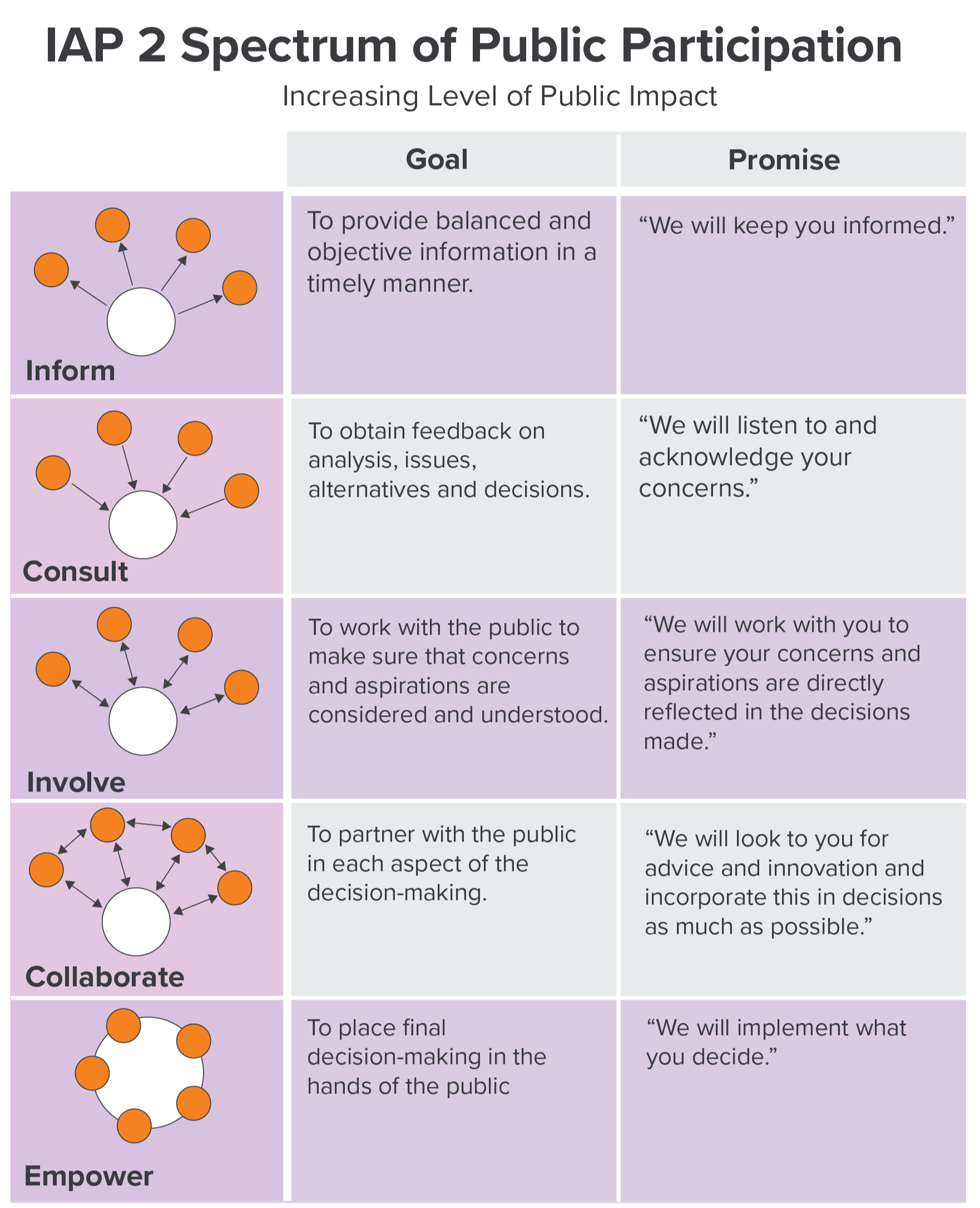 Diagram: IAP 2 Spectrum of Public Participation.
Diagram: IAP 2 Spectrum of Public Participation.
Key stakeholders
The project has attracted interest from a broad range of community members and stakeholders, located both near the project area and from across Adelaide and South Australia. It is anticipated that this interest will continue across the life of the project.
Key stakeholder groups engaged in the planning and design of the T2D Project include:
- State and Federal Government
- local members of parliament
- State Government departments and agencies
- Local Governments – elected members and officers
- service authorities
- emergency services
- registered Native Title Body Corporation (KYAC) and other Aboriginal groups
- local community along and near the corridor such as:
- businesses
- residents
- education institutions
- community, special interest and sporting groups
- property owners and tenants impacted by land acquisition
- T2D Community Reference Group
- Anzac and veterans groups
- non-government organisations, peak bodies and industry groups
- culturally and linguistically diverse groups
- disability groups
- broader public transport and road users
- wider South-Australian community.
This stakeholder list is reviewed on an ongoing basis to ensure all interested project stakeholders are appropriately engaged.
Engagement activities
Since the announcement of the T2D Project in 2020, the Department has been sharing information about the project and engaging with the community and key stakeholders to seek important input to help inform project decision making.
A range of tools have been used to engage with the community and stakeholders including meetings, workshops, letterbox drops, emails, a local face-to-face presence (at shopping centres, community hubs, information sessions) and digitally (via website, social media and online surveys).
The table below provides a snapshot of the key engagement phases so far for the T2D Project. The engagement approach, methodology and supporting collateral for each phase has been bespoke and planned to suit the specific engagement purpose.
| Engagement program timing | Engagement focus |
|---|---|
| Late 2020 – June 2021 | Raise awareness Introducing the T2D Project and understand how the community would like to be engaged. |
| June 2021 | Build understanding and seek early and ongoing input Gathering feedback on the proposed motorway functionality, community priorities and concerns. |
| October 2021 | Initial project design Presenting the initial project design to the community and encouraging the community to provide feedback on the design. |
| 2020 – ongoing | Early works Informing people about the works and ensuring impacts are minimised where possible. |
| Mid 2022 – ongoing | Land attainment Working closely with landowners throughout the acquisition process. |
| December 2022 – February 2023 | Outcomes of Government Review Seeking feedback on the changes to the design as a result of the review. |
| July 2023 | Local Area Traffic Management Seeking feedback on local access (current access and proposed future state) for walking, cycling, public transport and vehicles. Temporary noise wall Seeking feedback from York Avenue residents to inform the design of the temporary noise wall. |
| Mid 2023 – ongoing | Understanding local businesses Understanding the operational needs of local businesses to help inform construction methodology. |
| November 2023 | Code Amendment Undertaking the statutory consultation required for the proposed code amendment. Urban Design Strategy Creating awareness of the Urban Design Strategy and seeking input on urban design elements. |
| March 2024 | Project Assessment Report Presenting the Project Assessment Report for feedback. |
Updated project design released in December 2022
A review of the T2D Project was undertaken in 2022 to ensure it delivered the best possible outcome for South Australians. The review took place in response to a range of factors, including community feedback, and examined key parts of the design released in late 2021.
As a result of the review and community and stakeholder feedback, key changes were made to the project design as outlined below.
| What we heard | What we changed |
|---|---|
| Northern Tunnels, northern portal | |
| The visual impact of the proposed overpass near Brickworks Marketplace was unacceptable | We moved the motorway to the east so the elevated structure next to Brickworks Marketplace could be removed. To achieve this, the southbound section of South Road will pass over the corner of Hindmarsh Cemetery. This lower structure will not impact plots within Hindmarsh Cemetery. |
| Anzac Highway and improved connectivity | |
| The visual impact of the proposed Anzac Highway overpass and the removal of the right turn from Anzac Highway on to South Road are unacceptable | We removed the elevated structure that would have taken vehicles travelling from the south onto Anzac Highway towards the CBD. Right turns from Anzac Highway onto South Road have been reinstated. An off-ramp has been added on the motorway north of Anzac Highway to provide access to Richmond Road and James Congdon Drive. Traffic travelling north of Anzac Highway no longer needs to travel through the intersection at Anzac Highway and South Road. The new off-ramp also provides an alternative option to access the CBD and more direct access to Adelaide Airport. In addition, a new southbound on-ramp from James Congdon Drive will provide improved connectivity and an alternative for motorists to access the motorway. |
| Southern Tunnels, southern portal | |
| In addition to this, a technical review found that the tunnel portal needs to move approximately 300m to the north to improve traffic performance and safety. This design change will give motorists more distance and time to change lanes between Tonsley and the tunnel portal. It will provide better east-west connection via a shared-use bridge over the motorway and reduce long-term closures of the Darlington motorway during construction. | |
Engagement activities since December 2022
Following the release of this updated design, a significant engagement program was undertaken between December 2022 and February 2023. The primary purpose of this engagement was to seek feedback on the proposed design changes. It was also an opportunity to update the community and stakeholders more broadly on the other outcomes of the review.
During this engagement program, a broad range of engagement tools were utilised to ensure people had the opportunity to learn more and provide feedback in a way that was convenient to them.
Activities included:
- letterbox drop to 25,000 residents, businesses, and stakeholders along the T2D Project corridor (and email to 36,000 registered people) providing an overview of the changes and inviting feedback on the updated design
- meetings with interested residents and businesses
- briefings with local councils and industry
- local presence – four shopping centre pop-ups, two community hubs open (at the Brickworks and Clovelly Park) and eleven drop-in community information sessions
- online survey and interactive map inviting feedback on the updated design
- social media
- 1300 telephone line and email address.
New and revised engagement tools and information were launched to help inform the community about the project review, the design changes and invite feedback. This included new fact sheets, artist impressions and an animation, a new T2D Project website, re-launched social media platforms and a new online interactive map.
An opportunity was also provided for people to register their interest in joining a new Community Reference Group.
Since then, engagement with the community and stakeholders has continued, with feedback sought on several other key topics.
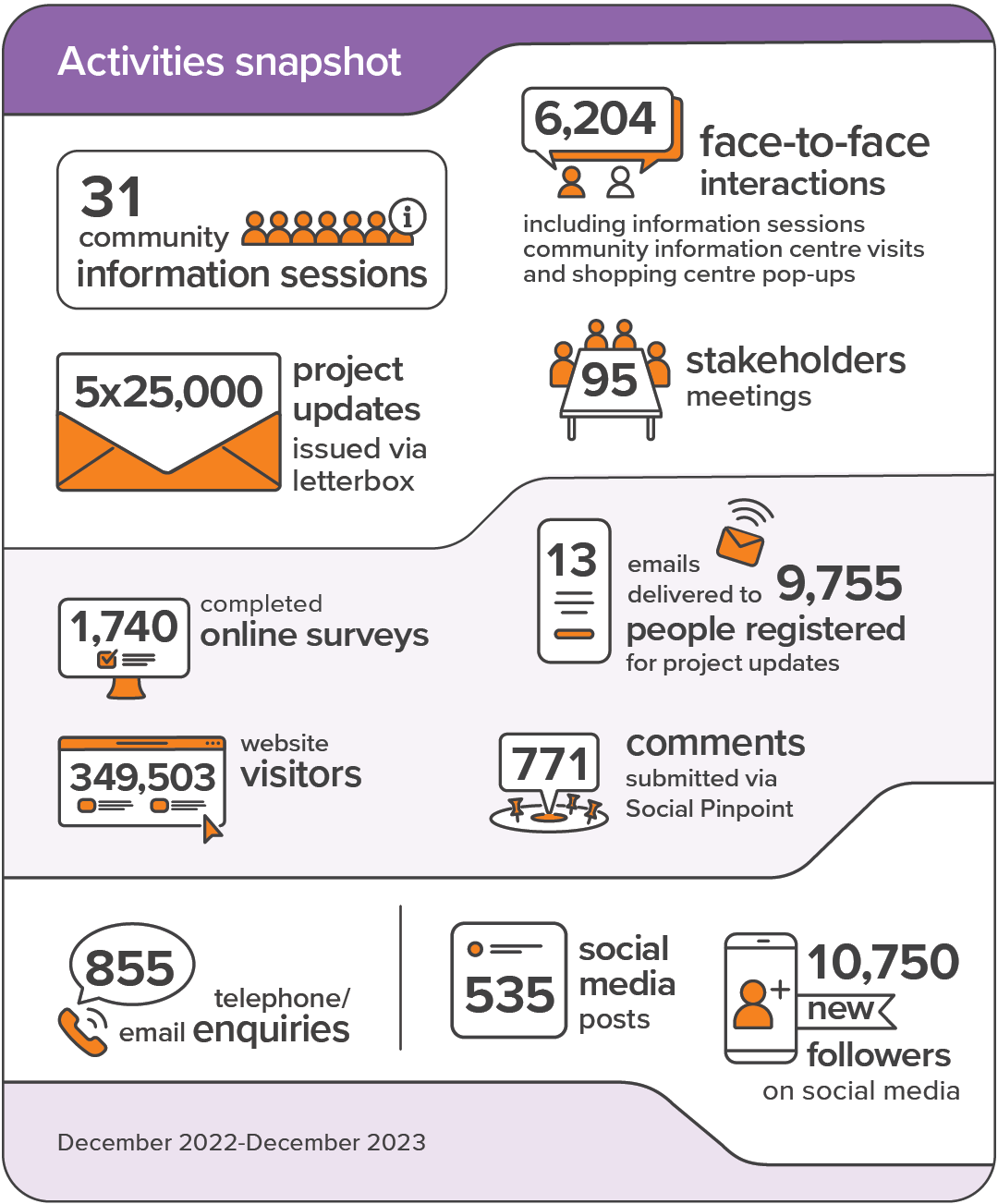 Image: Consultation activities snapshot.
Image: Consultation activities snapshot.
Feedback received
Feedback received has shown overall support for the T2D Project objectives to ease Adelaide’s traffic congestion and an understanding that the project will provide a major economic boost to South Australian businesses and the wider economy.
When the updated project design was shared in December 2022, there was a strong level of support for the T2D Project 68% of people felt positive or very positive towards the T2D Project. For more information see Community Consultation Report.
The key feedback raised during this engagement process included:
- there was a strong desire to learn more about the project design and how it would change the look and feel of local neighbourhoods
- people are keen to understand the reasoning behind the T2D Project and choice of alignment
- there was a sense of relief that community views had been heard particularly about the negative impacts of the previous design, the visual impact of elevated structures and the impacts on local areas of significance such as King’s Reserve and Hindmarsh Cemetery
- local access, traffic management and connectivity were important – specifically, access from local streets to and around South Road and the T2D motorway
- tunnel safety was of particular interest – including traffic management to enter and exit the tunnel and what occurs in the event of an emergency
- a number of people expressed their preference to retain Kings Reserve. There was disappointment about the loss of Thebarton Community Centre as an important community asset and people were keen to learn more about a suitable alternative for its relocation
- the importance of providing green space as part of the project was frequently raised
- there was concern about construction impacts, including access, noise, dust and visual amenity
- there was a strong desire to ‘just get on with it’ and see construction commence
- the importance of ongoing engagement and understanding local insights was reinforced.
Since then, feedback has been received across a range of other more specific topics. This feedback has been used to shape project decision- making. It has also been provided to the two shortlisted potential head contractors to ensure community insights are incorporated into their proposals.
Other key feedback
- Local area traffic management – local access for drivers, cyclists, pedestrians and public transport users was important, with useful insights shared about how people use the local network
- Individual business needs – changes to amenity, traffic conditions and temporary street closures need to be very carefully managed. On-going consultation and advance notice will be very important to ensure impacts are minimised as much as practically possible, there is a no-surprises approach and businesses can plan in advance
- Code Amendment – there was a low level of concern raised about the Code Amendment that will introduce new requirements to guide development near the new tunnels
- First temporary noise wall in Clovelly Park – there was support for the positioning of the wall and the use of soft landscaping plantings in front of the wall to improve visual amenity
- Urban design – there was strong support for high quality urban design outcomes for the project. There was particularly strong interest from the community in noise barriers, parks, other public spaces and active travel connections.
Next steps
Engagement with the community and stakeholders will continue across the life of the project. There is a lot more planning and detailed design work still to be completed. Opportunities to seek important insights will continue to be identified to help inform this process.
Engagement will also continue during the construction phase to ensure a ‘no surprises approach’ and the potential construction impacts on the local community are minimised. Want to know more?
- To find out about current and upcoming events and pop ups, see What's on.
- To stay up to date with the latest information, register for project updates.
- Looking for more information? Feel free to contact us.
